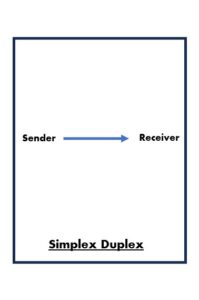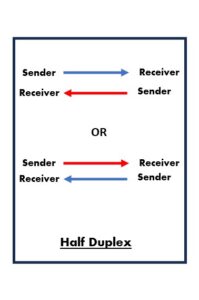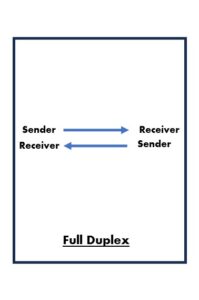Types of Duplex: Transmission Channels
In communication systems, transmission channels serve as the conduits through which data travels between sender and receiver. These channels come in various forms, each offering unique characteristics and capabilities to facilitate efficient data exchange. There are mainly 2 Types of communication channels: Simplex Communication and Duplex Communication. Duplex communication is further divided into 2types: Half Duplex and Full Duplex. Let’s learn more about them.
Simplex Communication

Simplex communication involves the unidirectional transmission of data, where information flows in only one direction, from the sender to the receiver.
- One-Way Traffic: Data travels in a single direction, prohibiting the receiver from sending data back to the sender.
- No Feedback Mechanism: The sender has no means of receiving feedback or acknowledgment from the receiver.
- Examples: Television and radio broadcasting, where signals are transmitted from the broadcasting station to viewers or listeners without any interaction or feedback.
If you are reading this, then why not read some more relevant articles given below?
Duplex Communication
Duplex communication encompasses bidirectional data transmission, allowing information to flow in both directions between sender and receiver. It includes two main modes: half-duplex and full-duplex communication.
Half Duplex Communication

In half-duplex communication, data can travel in both directions, but not simultaneously. Devices take turns transmitting and receiving data.
- One-Way-at-a-Time: Data transmission alternates between sending and receiving, akin to a walkie-talkie conversation.
- Switching Roles: Devices switch between the roles of sender and receiver, allowing bidirectional communication without simultaneous transmission.
- Examples: Two-way radios, intercom systems, and some Ethernet networks use half-duplex communication.
Full Duplex Communication

Full-duplex communication enables simultaneous bidirectional data transmission, allowing devices to send and receive data concurrently.
- Simultaneous Transmission: Data flows in both directions simultaneously, facilitating real-time communication.
- Independent Channels: Dedicated channels for sending and receiving data prevent collisions and ensure uninterrupted communication.
- Examples: Telephone conversations, most modern Ethernet networks, and wireless communication technologies such as Wi-Fi and Bluetooth utilize full-duplex communication.